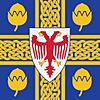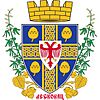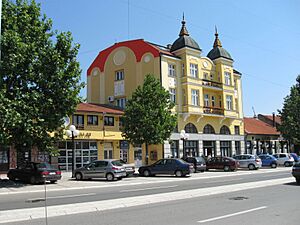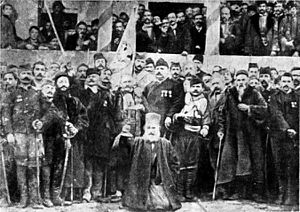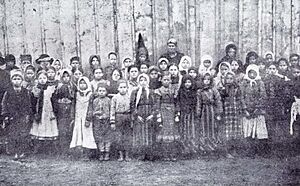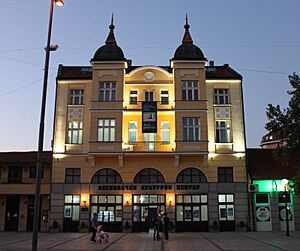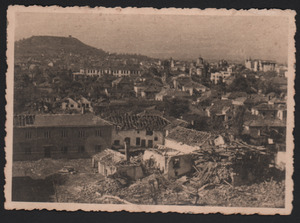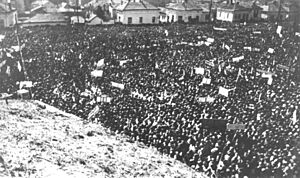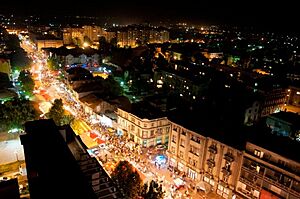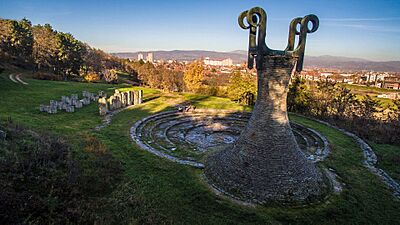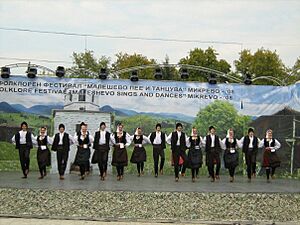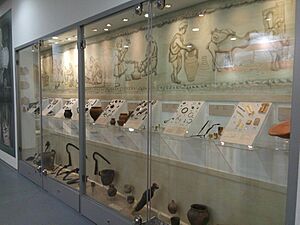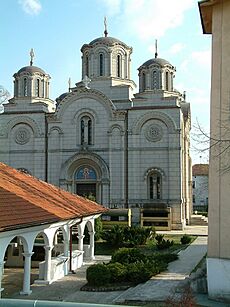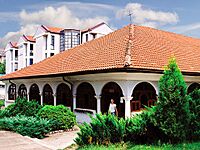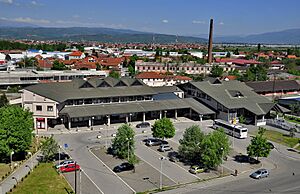Leskovac facts for kids
Quick facts for kids
Leskovac
Лесковац (Serbian)
|
|||
|---|---|---|---|
| City of Leskovac | |||
 |
|||
|
|||
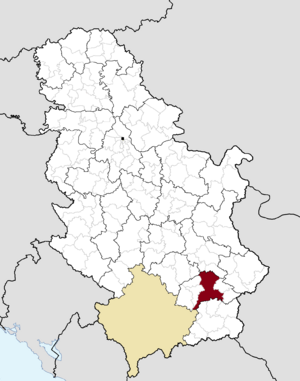
Location of the city of Leskovac within Serbia
|
|||
| Country | |||
| Region | Southern and Eastern Serbia | ||
| District | Jablanica | ||
| Settlements | 144 | ||
| Area | |||
| Area rank | 5th in Serbia | ||
| • Urban | 31.27 km2 (12.07 sq mi) | ||
| • Administrative | 1,025 km2 (396 sq mi) | ||
| Elevation | 228 m (748 ft) | ||
| Population
(2022 census)
|
|||
| • Rank | 6th in Serbia | ||
| • Urban | 58,338 | ||
| • Urban density | 1,865.62/km2 (4,831.9/sq mi) | ||
| • Administrative | 123,950 | ||
| • Administrative density | 120.93/km2 (313.20/sq mi) | ||
| Time zone | UTC+1 (CET) | ||
| • Summer (DST) | UTC+2 (CEST) | ||
| Postal code |
16000
|
||
| Area code | +381(0)16 | ||
| Car plates | LE | ||
Leskovac (pronounced lěskoʋats) is a city located in southern Serbia. It is the main administrative center of the Jablanica District. As of the 2022 census, the city of Leskovac has about 123,950 people living there.
Contents
What Does the Name Leskovac Mean?
Leskovac was once known as Glubočica or Dubočica. These names came from Serbian words meaning "mud" (glib) and "deep" (duboko). This was because rivers often flooded the area, leaving behind swamps.
After the swamps dried, many hazelnut trees grew there. The Serbian word for hazelnut tree is "leska". The ending "-ovac" is a common part of place names in Slavic countries. So, the name Leskovac means "place of hazelnut trees." During the time of Ottoman rule, the town was also called Leskovçe or Hisar, which means "fortress" in Turkish.
A Look Back: History of Leskovac
Early Times: Ancient Settlements
People have lived in the Leskovac area for a very long time. Archeologists have found signs of continuous life on Hisar Hill from the Bronze Age all the way to the 1800s. This hill was used as a fort for many centuries.
Pottery from the Iron Age has been found there. Other ancient groups like the Illyrians, Thracians, Dacians, Greeks, Romans, and Celts also lived around Leskovac. The Roman Empire took control of the area in the 1st century BC. They ruled until Slavic people, including the Serbs, settled there in the late 500s and early 600s.
The area, then called Glubočica or Dubočica, was first mentioned in the 1100s. It was given to the Nemanjić dynasty by a Byzantine Emperor. Leskovac itself was first named in 1348. This was when Serbian Emperor Dušan the Mighty gave it to the Hilendar Monastery. The region around Leskovac was often fought over during wars between the Bulgarian Empire and medieval Serbian states.
A big battle, the Battle of Dubočica, happened on September 24, 1454. The Serbian Despotate fought against the invading Ottoman Empire and won. However, Serbia eventually became part of the Ottoman Empire.
Under Ottoman Rule: A New Era
The Ottomans took over Leskovac in 1454. The town became known as Leskovçe or Hisar (fortress) in Turkish. Ottoman culture greatly influenced Leskovac. This included its buildings, food, customs, clothing, and language.
During this time, many mosques, schools, and Turkish baths were built. Leskovac became famous for its high-quality horse tack, leather tanning, metalwork, and weaving. People in the town worked as craftspeople, merchants, and farmers. The town was a mix of different cultures, including Serbs, Muslims, Jews, Greeks, and traders from other areas. Leskovac was also well-known for its annual 15-day fair.
Leskovac faced tough times, being badly damaged by fires in 1595 and 1690. During the Great Turkish War, many Serbs in Leskovac supported the Habsburg forces. After the Ottomans regained control, they punished the Serbs who had helped the Habsburgs. Many Serbs moved north.
In 1877, the Serbian Army entered Leskovac. Most of the Muslim population, mainly Turkish and Albanian, left the town as refugees.
From Turkish Town to "Little Manchester"
Leskovac became part of Serbia in 1878. Serbia gained full international recognition after the Treaty of Berlin.
Before the war, Leskovac was a key center for the textile industry. It worked closely with Bulgarian textile businesses. After gaining independence, Leskovac faced challenges. But it soon started to develop new technologies for processing rope and industrial hemp.
By the mid-1880s, Leskovac's textile industry grew quickly. It became the third largest urban area in Serbia, after Belgrade and Niš. A railway line connecting Leskovac to Belgrade, Skopje, and Thessaloniki opened in 1886. This helped the town grow even more. A special textile school opened in 1890. In 1903, the second hydroelectric power plant in Serbia was built on the nearby Vučjanka River.
Because of its booming industry, Leskovac was nicknamed Serbia's Little Manchester. This was in honor of Manchester, England, a famous city for textile manufacturing during the Industrial Revolution.
World War I and Bulgarian Occupation
During World War I, Leskovac was occupied by Bulgaria in 1915. This was a very difficult time for the people. There were attempts to make the local people more like Bulgarians. Many crimes were committed, and thousands of people were killed. Leskovac also suffered from a typhus epidemic and widespread hunger.
Bulgaria surrendered in September 1918. Leskovac was freed on October 7, 1918. Serbian and French forces led the liberation. Cheering crowds welcomed the Serbian Army as they entered the city.
The "Golden Age" of Leskovac
After World War I, Leskovac continued to grow rapidly. The town became a mix of Oriental and European influences. Wealthy industrialist families played a big role in society.
The growth of factories led to more workers and the rise of trade unions. In August 1920, Leskovac was one of the first places to elect the Communist Party. However, the government quickly stopped the party.
Even with its growth, Leskovac still lacked basic services like running water and paved streets. Many workers, who were mostly peasants, moved to the city. This led to poor housing and high death rates. From 1929 to 1941, Leskovac was part of the Vardar Banovina in the Kingdom of Yugoslavia.
World War II and Allied Bombing
During World War II, German forces occupied Leskovac on April 12, 1941. The town remained relatively quiet, except for a sad event called the Arapova Dolina massacre. In this event, 310 mostly Romani civilians were killed.
On September 6, 1944, Leskovac was heavily bombed by Allied forces. Much of the town was destroyed. About 2,500 to 4,000 people were killed or injured. Many buildings and factories were ruined. Leskovac was liberated by Partisan forces on October 11, 1944. After the war, the new Communist government removed political opponents.
Socialist Era and Recent Times
Leskovac remained a major textile center until the end of communism in Eastern Europe. However, due to economic problems and a failure to modernize its factories, the industry declined.
On April 12, 1999, during the NATO bombing of Yugoslavia, a bridge near Leskovac was destroyed by a NATO aircraft. A passenger train was crossing the bridge at the time.
Leskovac Today: Food and Festivals
Today, Leskovac is famous for its delicious Serbian food. This includes national dishes like pljeskavica (a grilled meat patty) and ćevapi (grilled minced meat rolls).
The annual Roštiljijada (Barbecue Week) festival is the city's biggest tourist event. It has been held since 1989 and attracts thousands of visitors. During the festival, the main street is closed, and food stands are set up. There are also competitions, like making the biggest burger.
The textile industry in Leskovac has largely collapsed. Many local businesses struggled to adapt to new economic changes. Issues like high unemployment and a shrinking population still exist. However, there has been some new investment, especially from foreign companies.
Where is Leskovac Located?
Leskovac is in the middle of a large and fertile valley. This valley is about 50 kilometers (31 miles) long and 45 kilometers (28 miles) wide. The small Veternica river flows through the city. Leskovac is located at the foot of Hisar Hill, about 228 meters (748 feet) above sea level.
The valley is surrounded by mountains. To the west are Radan and Pasjača. To the south are Kukavica and Čemernik. To the east are Babička Gora, Seličevica, and Suva Planina.
What is the Climate Like?
Leskovac has a humid subtropical climate. This means it has long, hot summers and short, cold, and cloudy winters.
| Climate data for Leskovac (1991–2020, extremes 1961–2020) | |||||||||||||
|---|---|---|---|---|---|---|---|---|---|---|---|---|---|
| Month | Jan | Feb | Mar | Apr | May | Jun | Jul | Aug | Sep | Oct | Nov | Dec | Year |
| Record high °C (°F) | 20.0 (68.0) |
24.8 (76.6) |
27.8 (82.0) |
32.6 (90.7) |
35.0 (95.0) |
38.6 (101.5) |
43.7 (110.7) |
41.3 (106.3) |
37.4 (99.3) |
35.0 (95.0) |
28.6 (83.5) |
21.4 (70.5) |
43.7 (110.7) |
| Mean daily maximum °C (°F) | 4.8 (40.6) |
8.0 (46.4) |
13.3 (55.9) |
18.7 (65.7) |
23.4 (74.1) |
27.5 (81.5) |
30.0 (86.0) |
30.5 (86.9) |
25.1 (77.2) |
19.1 (66.4) |
12.4 (54.3) |
5.7 (42.3) |
18.2 (64.8) |
| Daily mean °C (°F) | 0.2 (32.4) |
2.4 (36.3) |
6.9 (44.4) |
11.8 (53.2) |
16.4 (61.5) |
20.4 (68.7) |
22.3 (72.1) |
22.0 (71.6) |
16.8 (62.2) |
11.5 (52.7) |
6.4 (43.5) |
1.7 (35.1) |
11.6 (52.9) |
| Mean daily minimum °C (°F) | −3.6 (25.5) |
−2.1 (28.2) |
1.3 (34.3) |
5.3 (41.5) |
9.9 (49.8) |
13.5 (56.3) |
14.7 (58.5) |
14.3 (57.7) |
10.5 (50.9) |
6.0 (42.8) |
1.9 (35.4) |
−1.6 (29.1) |
5.8 (42.4) |
| Record low °C (°F) | −30.5 (−22.9) |
−26.8 (−16.2) |
−18.2 (−0.8) |
−6.1 (21.0) |
−1.7 (28.9) |
2.7 (36.9) |
5.4 (41.7) |
4.4 (39.9) |
−3.8 (25.2) |
−8.7 (16.3) |
−19.6 (−3.3) |
−21.7 (−7.1) |
−30.5 (−22.9) |
| Average precipitation mm (inches) | 46.2 (1.82) |
45.5 (1.79) |
52.1 (2.05) |
62.8 (2.47) |
69.4 (2.73) |
61.7 (2.43) |
51.2 (2.02) |
45.1 (1.78) |
52.2 (2.06) |
60.7 (2.39) |
55.5 (2.19) |
58.2 (2.29) |
660.6 (26.01) |
| Average precipitation days (≥ 0.1 mm) | 13.9 | 12.5 | 12.5 | 12.9 | 14.2 | 11.0 | 8.5 | 7.3 | 9.7 | 10.4 | 11.3 | 14.0 | 138.2 |
| Average snowy days | 9.0 | 7.4 | 4.7 | 0.8 | 0.0 | 0.0 | 0.0 | 0.0 | 0.0 | 0.3 | 2.8 | 7.6 | 32.6 |
| Average relative humidity (%) | 81.6 | 76.1 | 69.0 | 67.6 | 69.8 | 66.9 | 63.8 | 64.3 | 71.1 | 76.7 | 79.7 | 83.1 | 72.5 |
| Mean monthly sunshine hours | 67.0 | 88.3 | 146.1 | 178.6 | 219.6 | 264.6 | 301.2 | 293.0 | 202.6 | 139.8 | 84.8 | 50.5 | 2,036.1 |
| Source: Republic Hydrometeorological Service of Serbia | |||||||||||||
Rivers in the Leskovac Region
The biggest river in the Leskovac area is the South Morava River. It flows from south to north. Many smaller rivers flow into the South Morava. These include the Vlasina river, which comes from Lake Vlasina. The Veternica river flows through Leskovac itself. The Jablanica river starts in the Goljak mountains. The Pusta (Deserted) river begins on Radan mountain. The Vučjanka river flows from the Kukavica mountain.
Who Lives in Leskovac?
| Historical population | ||
|---|---|---|
| Year | Pop. | ±% p.a. |
| 1878 | 9,718 | — |
| 1884 | 10,878 | +1.90% |
| 1890 | 12,211 | +1.95% |
| 1895 | 12,989 | +1.24% |
| 1900 | 13,973 | +1.47% |
| 1931 | 17,636 | +0.75% |
| 1948 | 113,158 | +11.55% |
| 1953 | 121,311 | +1.40% |
| 1961 | 134,250 | +1.27% |
| 1971 | 147,487 | +0.94% |
| 1981 | 159,001 | +0.75% |
| 1991 | 161,986 | +0.19% |
| 2002 | 156,252 | −0.33% |
| 2011 | 144,206 | −0.89% |
| 2016 | 138,132 | −0.86% |
| 2022 | 124,889 | −1.67% |
In 2011, the city of Leskovac had 144,206 residents. Most of these people are Serbs. Other groups living there include Roma, Macedonians, and Yugoslavs. In 2007, there were about 500 people of Chinese origin in Leskovac.
Besides the main city, there are 143 other small towns and villages in the area. The largest of these are Vučje and Grdelica.
Most people in Leskovac are Orthodox Christians (96%). About 3% are Muslims. The rest follow other religions or are atheists.
Leskovac was once the second largest city in Serbia. However, it now faces economic challenges. Many working-age people have moved away from the area.
Villages and Subdivisions
There are 144 villages located within the municipality of Leskovac. Some of them are:
- Babičko
- Badince
- Barje
- Belanovce
- Beli Potok
- Bistrica
- Bogojevce
- Bojišina
- Boćevica
- Bratmilovce
- Brejanovce
- Brestovac
- Brza
- Bričevlje
- Bukova Glava
- Bunuški Čifluk
- Velika Biljanica
- Velika Grabovnica
- Velika Kopašnica
- Velika Sejanica
- Veliko Trnjane
- Vilje Kolo
- Vina
- Vinarce
- Vlase
- Vučje
- Gagince
- Golema Njiva
- Gorina
- Gornja Bunuša
- Gornja Jajina
- Gornja Kupinovica
- Gornja Lokošnica
- Gornja Slatina
- Gornje Krajince
- Gornje Sinkovce
- Gornje Stopanje
- Gornje Trnjane
- Gornji Bunibrod
- Gradašnica
- Grajevce
- Graovo
- Grdanica
- Grdelica
- Grdelica (village)
- Guberevac
- Dedina Bara
- Dobrotin
- Donja Bunuša
- Donja Jajina
- Donja Kupinovica
- Donja Lokošnica
- Donja Slatina
- Donje Brijanje
- Donje Krajince
- Donje Sinkovce
- Donje Stopanje
- Donje Trnjane
- Donji Bunibrod
- Draškovac
- Drvodelja
- Drćevac
- Dušanovo
- Žabljane
- Živkovo
- Žižavica
- Zagužane
- Zalužnje
- Zlokućane
- Zloćudovo
- Zoljevo
- Igrište
- Jarsenovo
- Jašunja
- Jelašnica
- Kaluđerce
- Karađorđevac
- Kaštavar
- Kovačeva Bara
- Kozare
- Koraćevac
- Krpejce
- Kukulovce
- Kumarevo
- Kutleš
- Leskovac
- Lipovica
- Ličin Dol
- Mala Biljanica
- Mala Grabovnica
- Mala Kopašnica
- Manojlovce
- Međa
- Melovo
- Milanovo
- Miroševce
- Mrkovica
- Mrštane
- Navalin
- Nakrivanj
- Nesvrta
- Novo Selo
- Nomanica
- Oraovica (Grdelica)
- Oraovica (Crkovnica)
- Orašac
- Oruglica
- Padež
- Palikuća
- Palojce
- Petrovac
- Pečenjevce
- Piskupovo
- Podrimce
- Predejane
- Predejane (village)
- Presečina
- Priboj
- Ravni Del
- Radonjica
- Razgojna
- Rajno Polje
- Rudare
- Svirce
- Slavujevce
- Slatina
- Smrdan
- Strojkovce
- Stupnica
- Suševlje
- Todorovce
- Tulovo
- Tupalovce
- Turekovac
- Crveni Breg
- Crkovnica
- Crcavac
- Čekmin
- Čifluk Razgojnski
- Čukljenik
- Šainovac
- Šarlince
- Šišince
Culture and Fun in Leskovac
Popular Events in Leskovac
Roštiljijada: Barbecue Week
The Roštiljijada is a famous grilled meat festival held every year in Leskovac. It usually takes place at the beginning of September. For five days, the main street is closed to traffic. Food stands are set up, offering delicious grilled meats.
This event attracts over 700,000 visitors from Serbia and other countries. There are also fun competitions, like making the biggest Pljeskavica (a type of burger). The Roštiljijada is a major highlight of the year in Leskovac.
International Carnival
Since 2009, Leskovac has been an official International Carnival city. It is part of The Association of European Carnival Cities. The Leskovac Carnival happens during the Roštiljijada festival. About 1,200 people take part, with many coming from other countries. The city government has thought about making this a separate tourist event.
Theater Marathon
The Theater Marathon is an annual event in November. It lasts for nine days. During this time, national theaters from all over Serbia perform plays. The event takes place at the National Theater in Leskovac.
Leskovac International Film Festival
The first Leskovac International Film Festival was held in 2008. The idea for a film festival in the city started much earlier, in 1996. Today, Leskovac hosts an international film festival.
The festival gives out awards in three categories:
- "Golden hazelnuts" - for the Best Director
- "Hazelnut leaf" - for critics' awards
- "Vox populi" - for the Audience Award
Important Cultural Places
- Monastery of John the Baptist, Leskovac
- Monastery of the Presentation of the Holy Mother of God, Leskovac
- Rudare Monastery
- Čukljenik Monastery
- Leskovac Cathedral
- Odžaklija Church
- Memorial Park to the Revolution (1971) by famous architect Bogdan Bogdanović
Sports in Leskovac
Leskovac has a rich history in sports. It is home to several sports teams. These include football clubs like GFK Dubočica and FK Sloga Leskovac. There is also a basketball team called KK Zdravlje and a handball team, RK Dubočica 54.
Economy and Transportation
How Leskovac Makes Money
Leskovac has a varied economy, but it is still growing. The industry is slowly increasing, and it is expected to grow more in the future. The main industries are light industries, such as textiles, household goods, and medical supplies. Leskovac also has a lead and zinc mine called "Leskovac Lece."
The city's economy first boomed after World War I, lasting until 1941. It grew again in the late 1940s. During the "Yugoslav economic miracle" (from the 1950s to about 1980), Leskovac became a major textile center in Southeast Europe. It was known as "Serbian Manchester." The Leskovac Lece mine was built during this time.
The table below shows how many people work in different types of jobs in Leskovac (as of 2022):
| Activity | Total |
|---|---|
| Agriculture, forestry and fishing | 279 |
| Mining and quarrying | 18 |
| Manufacturing | 15,090 |
| Electricity, gas, steam and air conditioning supply | 337 |
| Water supply; sewerage, waste management and remediation activities | 518 |
| Construction | 1,519 |
| Wholesale and retail trade, repair of motor vehicles and motorcycles | 5,577 |
| Transportation and storage | 1,256 |
| Accommodation and food services | 1,067 |
| Information and communication | 370 |
| Financial and insurance activities | 347 |
| Real estate activities | 105 |
| Professional, scientific and technical activities | 1,057 |
| Administrative and support service activities | 364 |
| Public administration and defense; compulsory social security | 1,506 |
| Education | 2,481 |
| Human health and social work activities | 2,853 |
| Arts, entertainment and recreation | 442 |
| Other service activities | 517 |
| Individual agricultural workers | 1,201 |
| Total | 36,906 |
Getting Around: Transportation
Leskovac is an important place for travel. International trains from Europe to Skopje, Thessalonica, and Athens pass through the city. Nineteen trains stop in Leskovac every day. The railway first came to Leskovac in 1886. Today, Leskovac has one of Serbia's newest and most modern railway stations.
Bus travel is also well-developed because many roads cross through Leskovac. The most important road is the E75 road. This road connects the borders of Hungary and Macedonia. Regional roads also lead from Leskovac to Priština, Pirot, and Bosilegrad. Leskovac is about 45 kilometers (28 miles) from Niš, 280 kilometers (174 miles) from Belgrade, and 155 kilometers (96 miles) from Sofia.
Leskovac has a regional airport. It is mostly used for sports and agricultural flights. In the summer, it is also used for air taxis. The closest international airport is Niš Constantine the Great Airport. It is about 45 kilometers (28 miles) north of Leskovac.
Caring for the Environment
Leskovac was the first city in Serbia to have a modern sanitary landfill. The Željkovac depot covers 80 hectares (about 198 acres). It is built to European standards. The landfill has a system to clean rainwater. It also has a center for sorting and disposing of waste. There are systems to detect all types of pollution. A company called Por Werner and Weber has started building a center for collecting and recycling waste. This makes Leskovac the first city in the Balkans to begin this kind of work.
Famous People from Leskovac
Many notable people come from Leskovac, including:
- Ahmed Ademović, a trumpeter and soldier.
- Jovica Arsić, a basketball coach.
- Obrad Belošević, a basketball referee.
- Jacques Confino, a doctor and writer.
- Nikola Dekleva, a doctor.
- Bojan Dimitrijević, an actor.
- Nenad Filipović, an athlete.
- Predrag Filipović, an athlete.
- Vlada Ilić - an industrialist and politician.
- Bojan Janić, a volleyball player.
- Sloboda Mićalović, an actress.
- Gojko Mitić, an actor.
- Vladimir Milošević, a pianist.
- Maja Miljković, a basketball player.
- Jovan Naumović, a Yugoslav Army General.
- Marko Perović, a footballer.
- Trajko Rajković, a basketball player.
- Nikola Skobaljić, a medieval nobleman and military commander.
- Jovan Spasić, a footballer.
- Predrag Stanković, a footballer.
- Nebojša Stefanović, an ultramarathon runner.
- Ljubiša Stojanović Louis, a singer.
- Goran Stojiljković, an athlete.
- Miodrag Stojković, a geneticist.
- Toma Zdravkovic, a singer.
- Bratislav Živković, a footballer.
Leskovac's International Friends
Twin Towns and Sister Cities
Leskovac has special friendships with other cities around the world. These are called twin towns or sister cities:
 Banja Luka, Bosnia and Herzegovina
Banja Luka, Bosnia and Herzegovina Bijeljina, Bosnia and Herzegovina
Bijeljina, Bosnia and Herzegovina Elin Pelin (town), Bulgaria
Elin Pelin (town), Bulgaria Kumanovo, Macedonia
Kumanovo, Macedonia Kyustendil, Bulgaria
Kyustendil, Bulgaria Lanzhou, China
Lanzhou, China Novo Mesto, Slovenia
Novo Mesto, Slovenia Pazin, Croatia
Pazin, Croatia Plovdiv, Bulgaria
Plovdiv, Bulgaria Prizren, Republic of Kosovo
Prizren, Republic of Kosovo Silistra, Bulgaria
Silistra, Bulgaria Verviers, Belgium
Verviers, Belgium Zrenjanin, Serbia
Zrenjanin, Serbia
Images for kids
See also
 In Spanish: Leskovac para niños
In Spanish: Leskovac para niños


